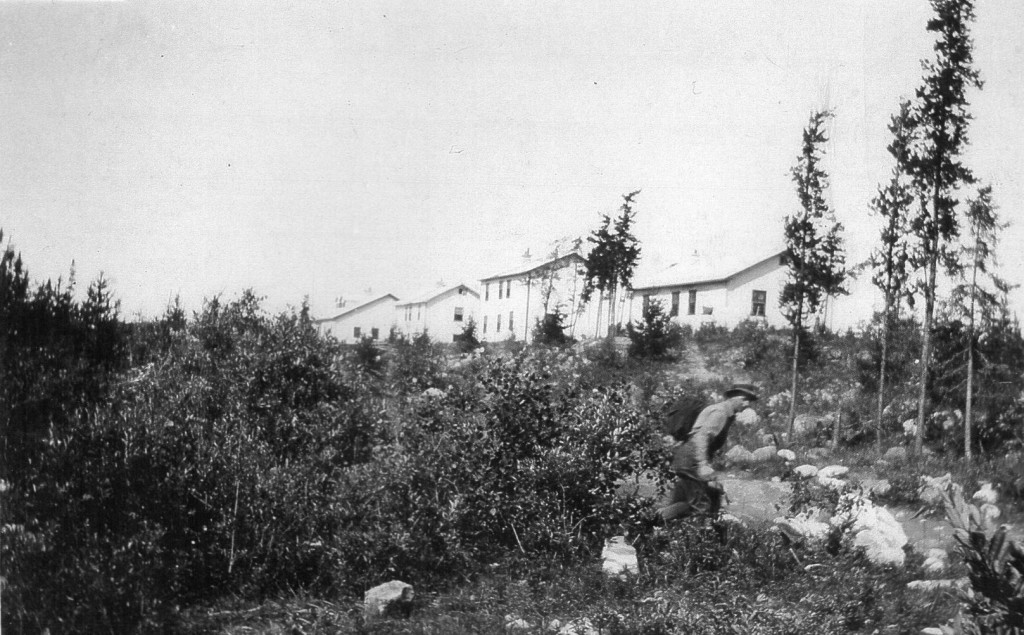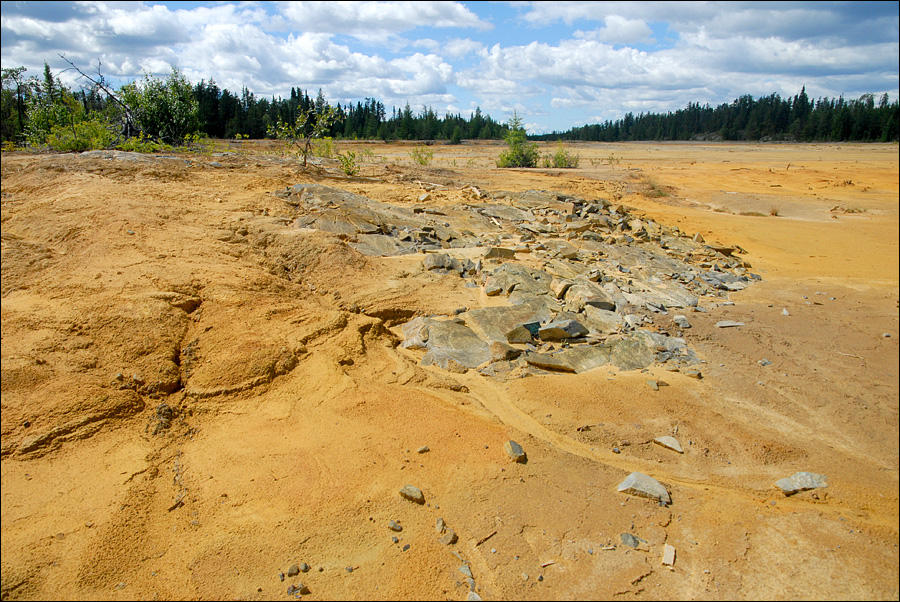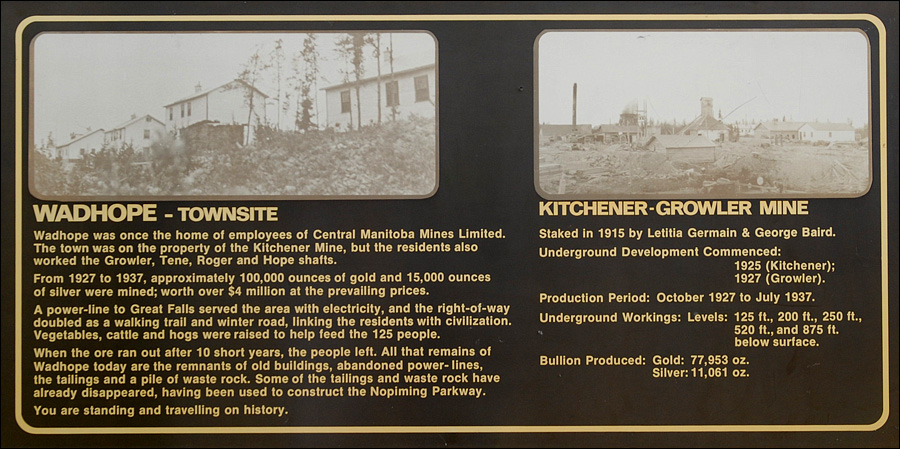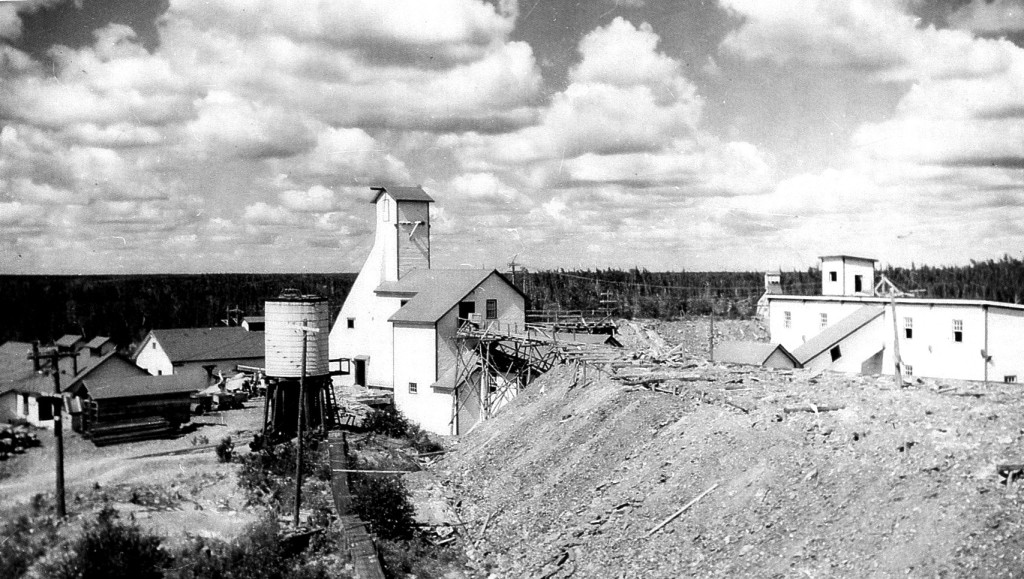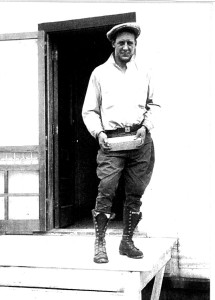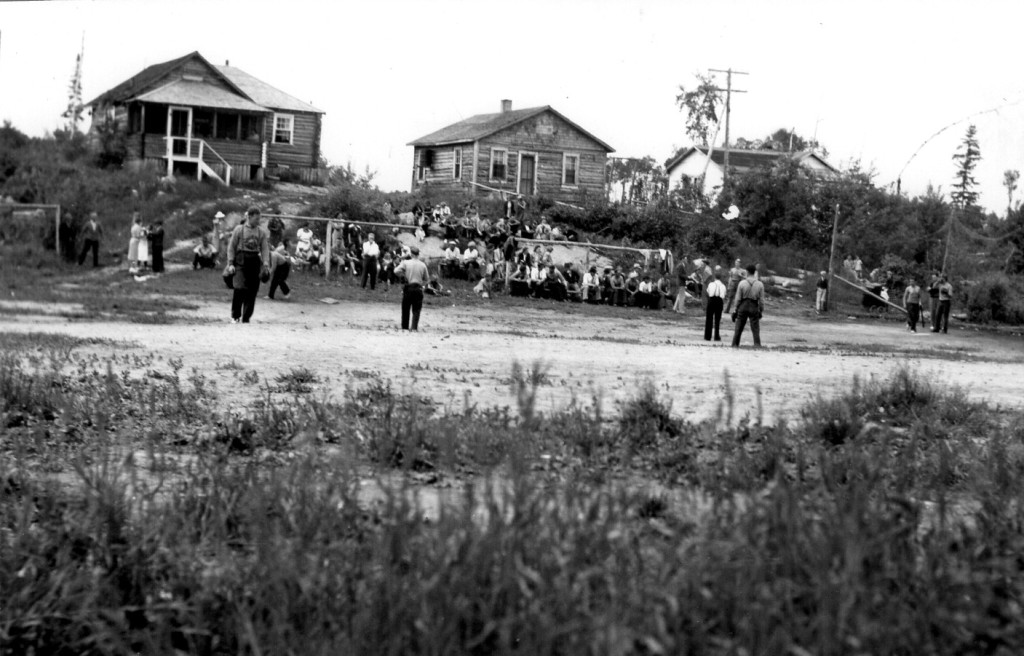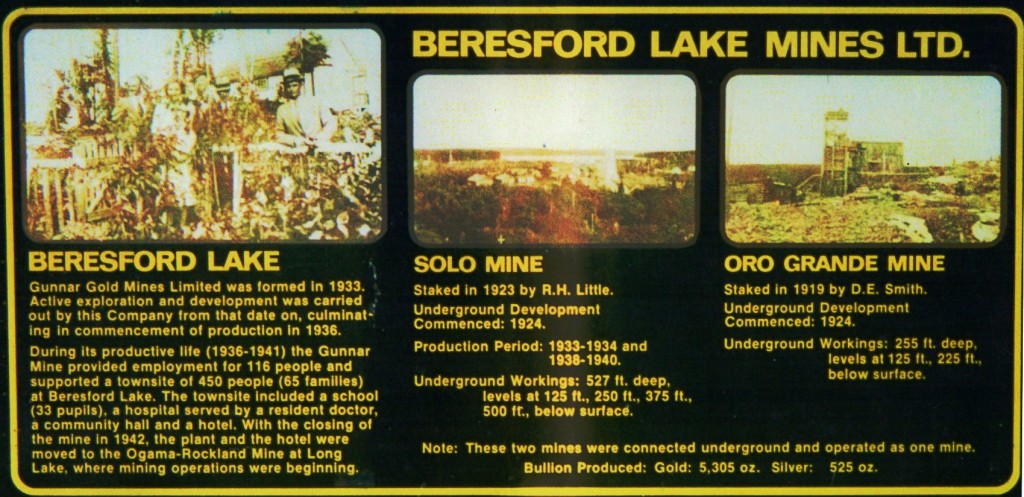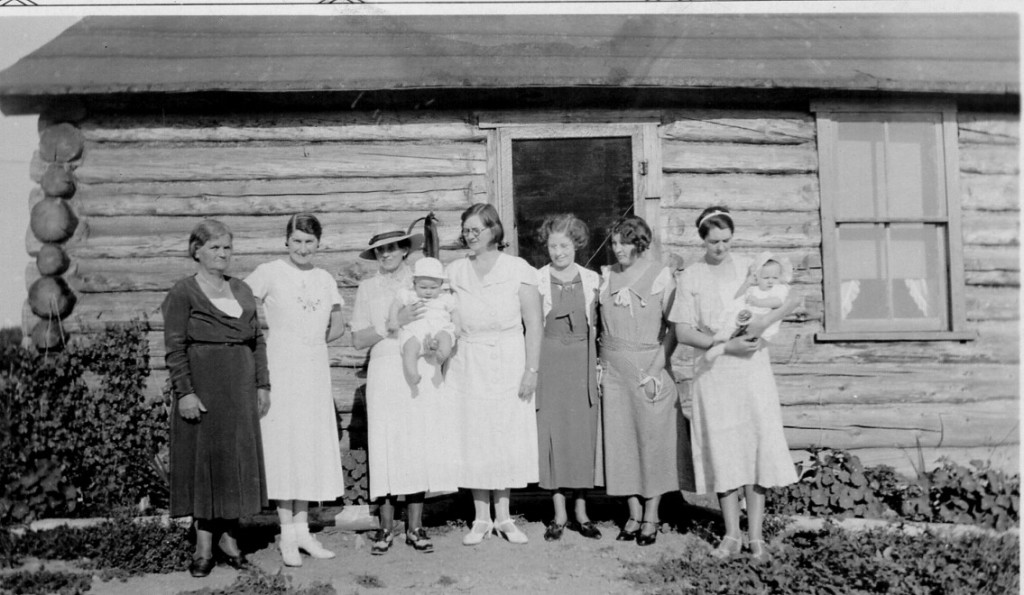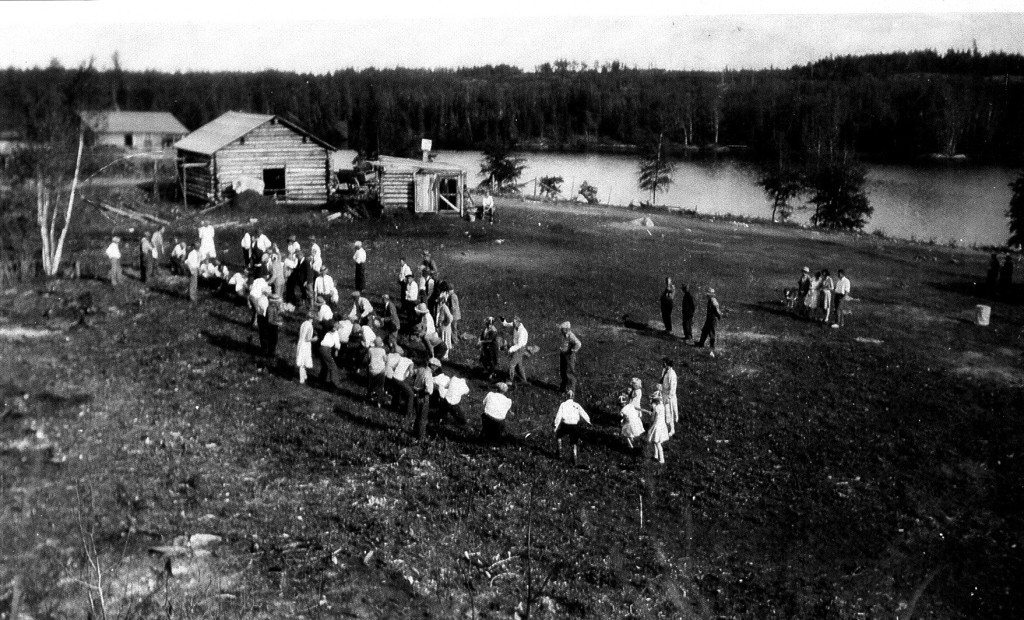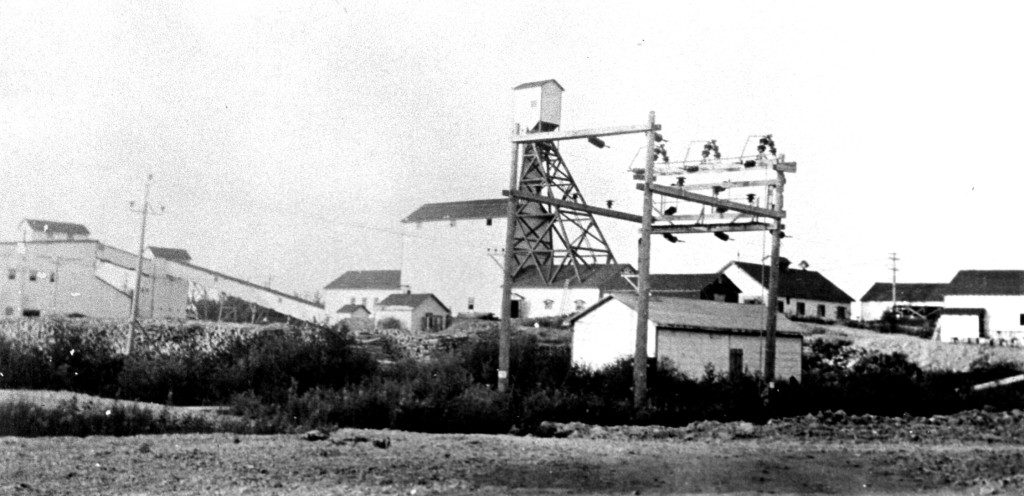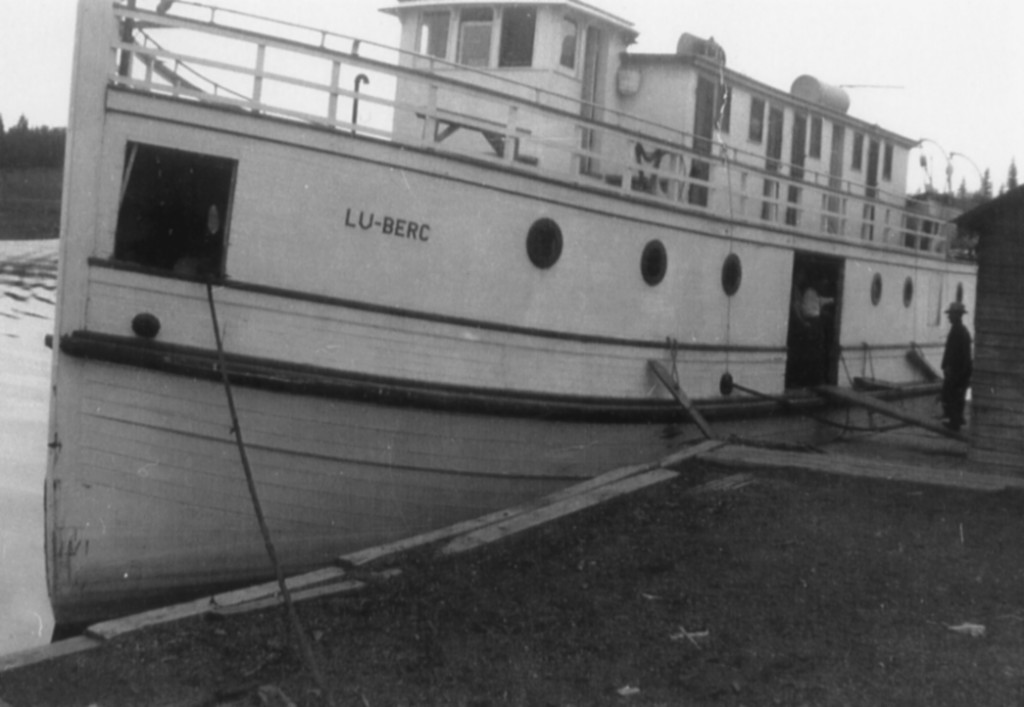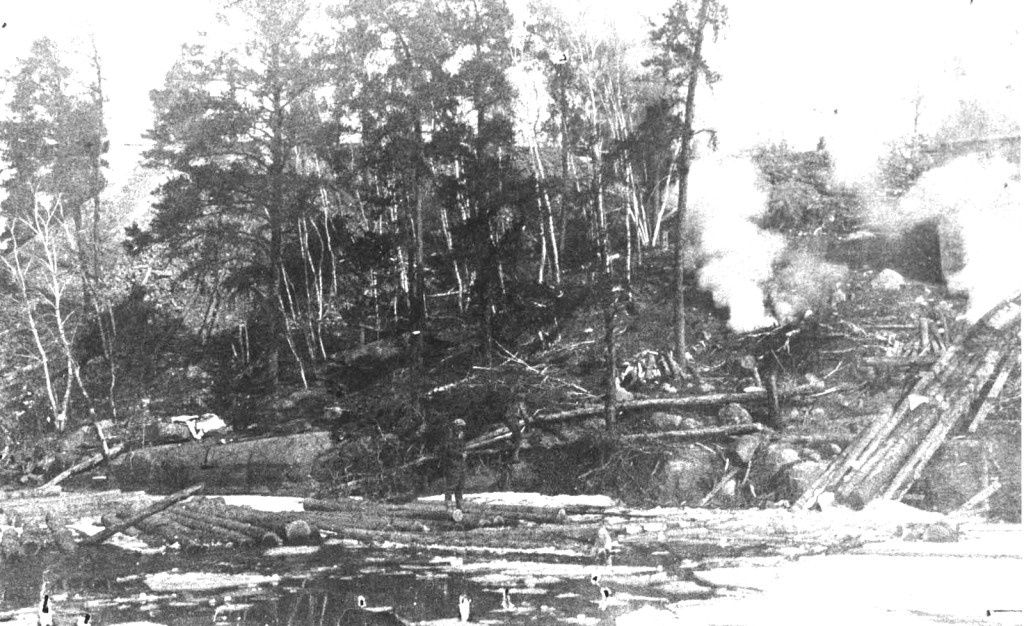Beginnings
The discovery of gold sparked an era of prospecting in the Wanipigow River watershed as well as in the area now known as Nopiming. These regions became the cradle of gold mining in Manitoba.
Prospectors from Kenora and Winnipeg flooded the area in canoes, following the old travel routes of Aboriginal people – the Bird (Oiseau), the Manigotagan and other rivers. With the possibility of striking it rich, the Shield wilderness took on a new meaning. Prospecting became a new way of seeing the old landscape, for the gold had always been there, since the molten rock had begun to cool.
In the period of exploration that followed, there was widespread staking, for there were many surface showings of “free gold,” or uncompounded gold which is visible to the unaided eye. Exotic gold rush names like Hidden Treasure, Paystreak, Lucky Strike and Gold Pick were attached to parcels of land in the wilderness and guarded jealously. Each claim represented someone’s hopes and dreams.
Some of those who came were long on enthusiasm but short on practical experience. There was more than one claim filed for fool’s gold or pyrites.
This gold rush was different from those of California and the Klondike where nuggets of the yellow element could be panned from a stream. The gold here was held fast by the Precambrian Shield and could only be extracted with a great deal of effort.
Prior to 1920, there was little development north of the Winnipeg River except for a few log cabins belonging to trappers and prospectors. Any ore that was obtained had to be packed in sacks and hauled away for processing. It became apparent that a full-fledged mining development would be required. This was to change the complexion of activities significantly. It was beyond the means of any one prospector to set up a mine, so some of them became salesmen and tried to peddle their claims to financial backers.
Central Manitoba Mine Ltd.- in production 1927-1937
One of the earliest and most successful mining developments was the Central Manitoba Mine, 6.5 km north of Long Lake. Its original claims were the Redwing, Goldbird, Fighter, Growler and Kitchener. Eventually, the Central Manitoba Mine comprised 5 shafts, each sunk into a different gold-bearing quartz vein.
The Kitchener, staked in 1915 by Louis Simard, was the site of the first shaft. One February morning as the men were handsteeling the shaft elsewhere on the property there was a total eclipse of the sun. The shaft was thus called the Eclipse. Timber for the headframe and other buildings was obtained at nearby Stormy Lake, noted for the tall spruce around it.
Work commenced on a winter road between Long Lake and Great Falls, about 70 km (43 miles) to the south, a power transmission line was built from the new dam, and electricity was introduced to the mine in 1927 when it went into full production. Prior to this all machinery was steam operated.
The summer route to the Central was a complex and changing one. The first part was by freighter canoes up the Manigotagan River system. However, because of its 30 portages, it was abandoned after a few years of use. A more efficient water-land route used the Wanipigow River as far as Government Landing. From there, horse-drawn wagons (later trucks) followed the 29-km (18-mile) Caribou Road to Caribou Landing. Work on this road began as early as 1922 when it was just a path between mineral claims. Today, a portion of it remains close to its rugged original state. From Caribou Landing freight was taken by boat across Quesnel Lake to Manigotagan Lake which was connected to Long Lake by means of a tracked portage. Once across Long Lake, roads led to the Central and other mines.
The Community of Wadhope
As the Central grew, a small community began to evolve. About 125 people were employed by the operation alone. This place in the wilderness had an air of permanence. During the Depression of the 1930s, many walked the long road to the Central and other mines in search of work. The community of Wadhope took its name from the initials of the financing syndicate and Hope, which was the name of one of the more promising mineral claims in the Central’s holdings.
The townsite practically surrounded and extended to the south of the mine plant buildings and Kitchener Shaft. It was approximately 4 ½ miles northeast of Long Lake and about 125 miles northeast of Winnipeg.
Amenities included a general store operated by the Campbell brothers (who also operated stores at other mines in the region), which included a post office and a pool room. Also built were bunkhouses and a cookhouse for single men, barber shop, laundry, confectionery and butcher shop, a recreation hall (which also housed the school until a one-room school was built), and a 3-bed hospital.
The life of the mine and the small community was brief, as exploration failed to turn up any worthwhile veins below the 114 m (375 ft.) level. In its years of production from 1927 to 1937, the Central produced 4,537 kg (160,034 oz.) of gold and 738 kg (26,032 oz.) of silver with a total value of $4,106,970, at prevailing prices.
Despite its short life, the Central proved to be a catalyst for other mining developments in the area, including the introduction of electricity and a transportation system. Some who became unemployed due to the closure found jobs with other mining operations which ran at various times, including the Gunnar Mine at Beresford Lake and the longest lasting, San Antonio Mine at Bissett.
Today, very little remains of the Central. Along the Nopiming Trail, a few kilometres north of Long Lake, there is a break in the rocky, forested, roadside scenery. The reddish sands are the tailings from the Central’s ten years of production. At the mine site, the shafts are capped and poplar and alder grow from the foundations of the former mine buildings.
(from the website of the Govt. of Manitoba, Parks and Recreation, Parks and Natural Areas, Nopiming Provincial Park, and from the paper “The Mining Communities of The Central Manitoba Mining Area” written by John Minton in 1988.)
Gunnar Gold Mines Ltd., Beresford Lake – In production 1936-1942
Gunnar Gold Mines, originally incorporated under the laws of the Province of Ontario in 1933, was staked by Gunnar Berg, (from whom the mine received its name), Leo Seeberg, Bill Walton and Willie Quesnel.
The mine was located about one mile inland to the west from the townsite of Beresford Lake. The mill started production in 1936 and the mine ceased operations and closed in 1942 after treating 298,820 tons of ore and producing 101,463 troy ounces of gold.
The Beresford Lake townsite was located on the west shore near the south end of Beresford Lake and was 125 miles north-east of Winnipeg. The majority of the homes were small log cabins and spread out along the lakeshore. A bunkhouse and cookery was provided for single employees.
Amenities in the town included a store (operated by Leith Campbell who also operated a store later at Ogama-Rockland Mine and at Bissett), a hotel, a one-room school, a community hall, and a curling rink.
A road connected Long Lake and Gunnar Mines.
(thanks to John Minton cited above)
Ogama-Rockland Gold Mines Ltd., Long Lake – In production 1942-1951
This property was staked by Gunnar Berg, Lee Seeberg, Bill Walton and Willie Quesnel in 1915. The mine was a subsidiary of Gunnar Gold Mines Limited and was situated about one mile north of the townsite on Long Lake. Both the mine and townsite were connected by a 25 mile gravel road with the San Antonio Gold Mine and the town of Bissett.
While there had been preliminary sampling and diamond drilling prior to 1942, no extensive development was undertaken until 1941, at which time the ore was hauled to the Gunnar mill for treatment. In 1942 the Gunnar Mine suspended operations and it was decided to cease operations until after the war.
Production resumed at Ogama-Rockland in 1948 following the move of the complete mining plant at the Gunnar Mine, as well as the staff townsite houses. Production continued for three years before the mine and mill closed down in 1951 when the ore ran out at above the 1,000 foot level. During that period 50,000 ounces of gold were produced.
The townsite was located on the north shore near the east end of Long Lake, which is about 7 miles west of Beresford Lake.
Single employees were housed in the usual bunkhouses with access to a cookhouse. Family dwellings were built on lots along the shore of Long Lake.
Town amenities included a 3 bed hospital, a general store, a log hotel (moved from the Gunnar site, and later transported log by log to Manigotagan), a one room school, a community hall and a curling rink.
(thanks to John Minton cited above)
Manigotogan
The community of Manigotogan is situated on the east shore of Lake Winnipeg, near the mouth of the Manigotogan river, which provided a deep natural harbor for vessels on the Lake and was consequently a likely site for habitation and industrial development.People have lived in the area of the Manigotogan River where it meets Lake Winnipeg, for at least 6,000 years. People lived off the land as hunters and gatherers, relying on the area’s natural resources. And the present-day inhabitants still connect to these cultural roots.
The current town of Manigotogan is located near the original site of a trading post operated by the Hudson’s Bay Company, called Bad Throat Post (Bad Throat is the meaning of the Anishinabe word Manigotogan), established in 1887, operating not only for the fur trade, but because of the wealth of the timber resources of the area.A sawmill had been established in 1868 by Henry McKinney with the lumber being shipped to Winnipeg, where the developing city provided a rich source of buyers. While this venture foundered after a few years, more sawmills followed, and the timber industry became an important part of the economy in Manigotogan.
When gold was discovered in the Bissett area in 1911, Manigotogan became an important transportation hub for that industry, providing access for passengers and equipment going to the mining communities that sprang up east of Lake Winnipeg. And the deep natural inlet of the Manigotogan River provided a fine harbor for lake boats that were used to transport logs, equipment, supplies and passengers to and from Winnipeg. At first, land routes from Manigotogan to Bissett and the other mining communities were by water, ice and bush roads, but eventually gravel roads to Bissett and to Pine Falls were built; but not before 1960 did these achieve the status of “all weather” roads.
The first school in Manigotogan was built in the early 1920’s, when there were about twenty families living in the community. A community hall was constructed in the ‘30s.A hotel was built and when it burned down was replaced by the North Star Hotel which was trucked in from Long Lake in 1952. It continued to shelter travelers to and from Bissett for many years until it too burned down in 2016.Roman Catholic, Mennonite and Anglican churches were established in 1932, 1959 and 1963 respectively.
The first formal organization of a town council and mayor was established in 1968.
(Thanks to Charles and Freeman Simard, the Manitoba Eco Network and Wilda Ward, Bissett – 100 Years of Gold)


